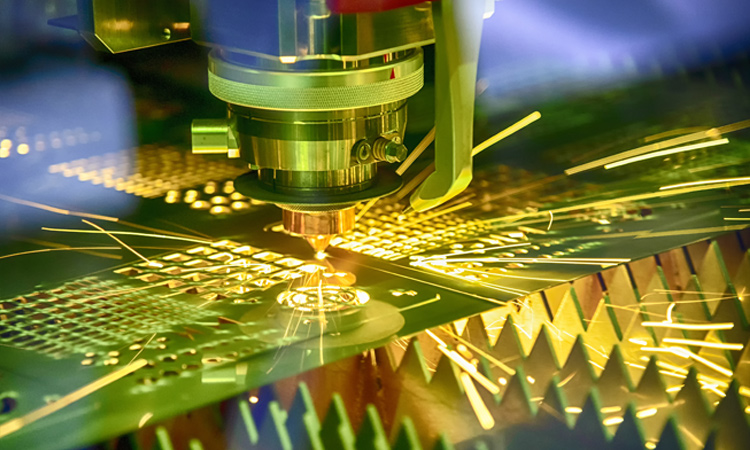 [Getty Images]
[Getty Images]
When the U.S. Navy announced plans to test its 30-kW LaWS (Laser Weapon System) on the USS Ponce several years ago, the technology news editor of New Scientist asked me what type of laser it used—and was astounded when I told him it contained industrial fiber lasers. The surprise was understandable. Having covered the Airborne Laser, a megawatt-class chemical-laser behemoth that filled the interior of a Boeing 747, he expected that a laser weapon would have to be massive.
For decades, the Pentagon had likewise thought it needed big lasers to make powerful weapons. Elias Snitzer had used a fiber-like core-cladding structure to make the first glass laser at the American Optical Company in 1961, and military developers had tried to scale such lasers into logs that would fire powerful pulses. But so much heat accumulated in the thick glass rods that they shattered. After that, the U.S. military turned to flowing-gas lasers to remove the waste heat. The Airborne Laser program, which lasted from the mid-1990s to 2012, was the last of that line.
Elias Snitzer opened the door to high-power fiber lasers in 1988, when he developed a new fiber structure to better couple pump light into the fiber.
Fiber laser revival
Snitzer re-opened the door to high-power fiber lasers in 1988, when he developed a new fiber structure to better couple pump light into the fiber. Diode pumping had emerged for solid-state lasers in the 1980s, but for fiber lasers this initially had required coupling the pump light into the small central core. Snitzer added an extra glass layer between the traditional high-index fiber core and low-index cladding.
This inner cladding had a refractive index lower than the core but higher than the outer cladding. Thus the boundary between the core and the inner cladding confined the laser light generated in the neodymium-doped core, while the boundary between the inner and outer cladding confined the diode pump light in the inner cladding. Development on that foundation continued, with changes in fiber geometry, doping and diode combinations contributing to increases in brightness, power and energy efficiency (see infographic at right).
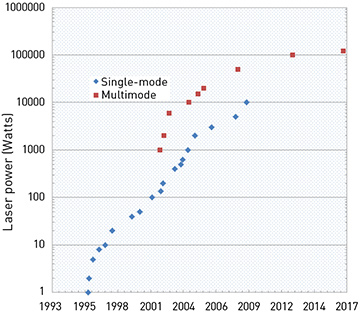 Power on the rise: Growth in power of IPG Photonics fiber-laser offerings in the past quarter-century. [IPG Photonics]
Power on the rise: Growth in power of IPG Photonics fiber-laser offerings in the past quarter-century. [IPG Photonics]
The mid-1990s boom in fiber optic communications diverted most companies’ attention from lasers to development of fiber amplifiers, but IPG Photonics, founded in Moscow in 1990 by OSA Fellow Valentin Gapontsev, made major progress in ytterbium-doped fiber lasers. The company started with a one-watt single-mode fiber laser in 1995; by 2004, it had reached single-mode continuous output of one kilowatt. About two years earlier, IPG had also introduced a multimode fiber laser that relied heavily on tapered fiber bundles, both to concentrate the pump light and to combine the output of separate single-mode lasers; the power of that product line soon reached several kilowatts. As power levels rose, the company focused on industrial applications that could use multimode beams.
IPG reported a record 10 kW from a single-mode fiber laser in 2009, an impressive engineering achievement that remained a plateau for single-mode fiber lasers for several years. The system was a tandem oscillator-amplifier that started with a diode-pumped 1-kW fiber laser oscillating at 1070 nm. The key to reaching 10 kW was pumping the 15-m fiber amplifier that followed it with 45 diode-pumped single-mode Yb fiber lasers emitting at 1018 nm. The absorption and emission bands of ytterbium overlap, with absorption at 850-1080 nm and emission at 980-1100 nm; the 1018-nm pump line can produce a population inversion at 1070 nm. The photon defect of that system is less than 5 percent, which eases thermal management, a key consideration for high-power single-mode lasers.
According to a recent review article by Michalis Zervas and Christophe Codemard, tandem pumping is needed for diffraction-limited single-mode beams with powers over 3 kW (it’s not, however, needed for high-power multimode fiber lasers). In recent years, IPG has extended single-mode fiber lasers to 15-20 kW, says Bryce Samson, IPG’s director of North American sales.
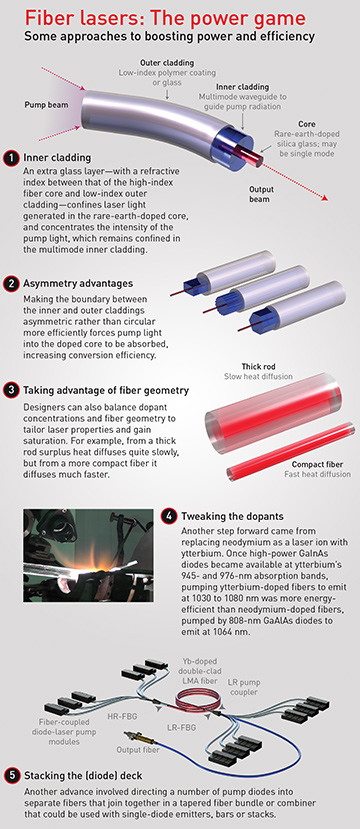 [Illustration by Phil Saunders]
[Illustration by Phil Saunders]
More power than industry needs?
Multimode fiber lasers can operate at continuous power levels to 100 kW because their larger cores spread the laser power through a larger volume, reducing the power density that contributes to nonlinear effects. Their primary use is in industrial materials working, a billion-dollar market for fiber lasers. “We developed the 100-kW multimode laser for a particular subset of customers,” says Samson of IPG. But the laser alone was not enough. The company also had to develop a special laser head for beam delivery to facilitate the deep-welding applications where such powerful beams seemed attractive. In other words, the technology for building high-power fiber lasers had gotten ahead of user needs at the highest power levels.
IPG’s single largest market for high-power fiber lasers is cutting, and Samson says that 8-to-10-kW multimode fiber lasers have become common in that field only in the past two or three years. IPG has offered those powers for more than a decade, but users couldn’t do much with them until special cutting heads were developed for that power range. A beam parameter product (BPP) of 4 mm-mrad is a sweet spot for industrial cutting, he says. (BPP is the product of the beam radius and the beam divergence angle; a low BPP generally means a high beam quality.) Multimode beams are cost-effective for industry because they can be focused well enough for the beam-delivery distances needed in factories.
Current high-power fiber laser technology is five to ten years ahead of most customer needs, Samson says. IPG’s main business is supplying lasers to OEMs that build them into machine tools, which move the beam and the workpiece. Companies typically need three to five years to develop a new product around a new laser and start delivering it to customers. Customers who cut mild steel plates don’t need really high power, according to Samson. “They are more interested in robust and reliable systems, with good service and warranty,” he says.
Overcoming nonlinear effects
The high beam quality of single-mode fiber lasers attracted other users, from the research to military communities, who wanted higher powers along with good beam quality. That required overcoming nonlinear effects that increase with power density and the distance light travels through the fiber, which could be done by increasing the effective mode area in single-mode fibers.
The core diameter needed to maintain single-mode transmission in an optical fiber depends on the refractive-index difference between the core and cladding; the smaller the difference, the larger the diameter of a core that could support single-mode transmission. For passive fibers used in telecommunications, a typical index difference is one percent, and a typical single-mode core diameter (for 1.3-µm transmission) is around 9 µm.
Nonlinear effects in a fiber laser are proportional to the core area, so reducing the core-cladding difference enough to double the single-mode core diameter should allow a solid fiber laser to deliver four times more power. The actual effects are more complex, because reducing the core-cladding refractive-index difference comes with tradeoffs. Large-mode-area fibers typically allow propagation of some higher-order modes, but fibers can be designed or installed to attenuate higher-order modes with little effect on the fundamental mode.
Microstructured or photonic-crystal fibers, in which parallel holes run along the fiber axis, can provide even larger effective core areas for single-mode transmission. For fiber lasers, the holes are fabricated in the inner cladding, which guides the pump light, leaving the doped core solid. This led to development of “rod-type” photonic crystals, which get their name because they are so large and thick that they become inflexible.
In 2006, for example, Jens Limpert’s group at Friedrich Schiller University (FSU) Jena, Germany, made a fiber with an 85-µm doped solid active core and a 200-µm microstructured inner cladding for collecting and guiding pump light, surrounded by an “air cladding” with closely spaced large air holes to confine the pump light. The rod-like fiber had a mode-field diameter of 70 µm and a 1.5-mm outer cladding.
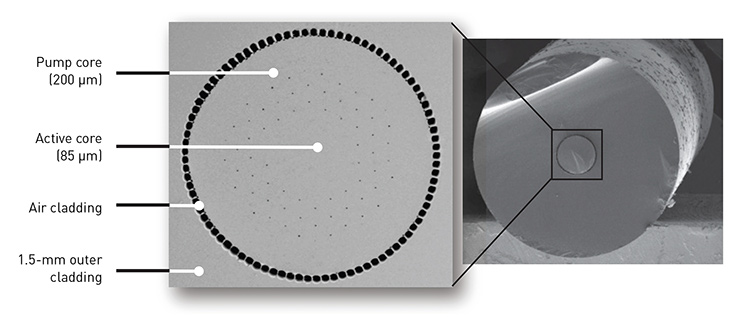 In a “rod-type” photonic-crystal fiber, parallel holes along the fiber axis confine and guide light, providing even larger effective core areas for single-mode transmission. [J. Limpert, OFC Conference 2017, paper W1F.5]
In a “rod-type” photonic-crystal fiber, parallel holes along the fiber axis confine and guide light, providing even larger effective core areas for single-mode transmission. [J. Limpert, OFC Conference 2017, paper W1F.5]
Further progress has led to new designs for microstructured fibers that have reached mode-field diameters of about 130 µm. Those fiber lasers have large spacings—10 to 30 times the laser wavelength—between holes in their inner claddings. The large spacing eases fabrication tolerance, but the rod-like fibers must be kept very straight during laser operation to prevent the mode field from collapsing. However, their maximum output is limited by thermal effects that change waveguiding as the output increases, reducing mode-field diameter.
Military applications
Perhaps the most surprising success of high-power fiber lasers has been in military systems for defense against relatively short-range weapons, such as rockets, artillery, mortars, small boats and drones.
When the U.S. Department of Defense (DoD) shifted its focus to developing electric lasers as weapons, a panel of the U.S. National Academy of Sciences doubted that fiber lasers could be scaled to high enough powers and good enough beam qualities to meet military requirements. The first solid-state lasers to demonstrate the key goal of 100-kW output, for five solid minutes, were diode-pumped slabs from Northrop Grumman in 2009 and Textron in 2010. Fiber lasers were coming on strong in industry, but their limited output in a single mode was a serious concern for laser weapons.
Developers got around the limits on single-mode fiber lasers by finding ways to combine the beams from multiple fiber lasers to generate high-power, high-intensity beams. The simplest approach is incoherent beam combination, which Phillip Sprangle and colleagues at the U.S. Naval Research Laboratory tested by combining beams from four fiber lasers onto a target 3.2 km away. They delivered a total of 5 kW to the target, and concluded that at such distances there “is little difference in the energy on target between coherently and incoherently combined laser beams for multi-kilometer propagation ranges and moderate to high levels of turbulence.”
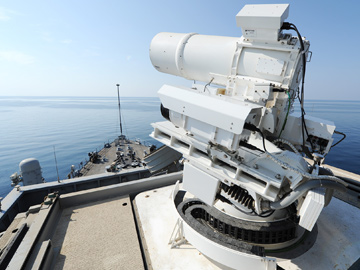 The U.S. Navy’s fiber-based Laser Weapon System (LaWS) was tested in 2014 aboard the USS Ponce in the Persian Gulf. [U.S. Navy photo]
The U.S. Navy’s fiber-based Laser Weapon System (LaWS) was tested in 2014 aboard the USS Ponce in the Persian Gulf. [U.S. Navy photo]
That inspired the U.S. Office of Naval Research to buy half a dozen 5.5-kW industrial fiber lasers from IPG, and combine their beams incoherently by aiming them with different mirrors through a single telescope toward the same target. Called Navy LaWS, for Laser Weapon System, it was mounted on the USS Ponce when it was deployed to the Persian Gulf. YouTube videos show how the laser destroyed drones and detonated explosives floating on a small boat, although the distances were not identified. The tests were generally encouraging, but showed that thermal blooming, air turbulence and heating of laser optics could make it difficult to deliver continuous powers above 100 kW beyond 5 km. The military wanted more power and more distance.
One long-studied alternative is coherent beam combination, which seeks to carefully match the phases of beams from separate fiber lasers or amplifiers so the light interferes constructively to yield high power and high intensity. This is analogous to phased-array radar, which matches the phases of radio waves emitted by separate antennas operating at the same frequency to produce a powerful steerable beam.
Phase matching at optical wavelengths, however, is much harder, because the wavelengths are thousands of times smaller and must be matched with much greater precision. Phase matching can be eased by dividing light from a single master oscillator among many parallel fiber amplifiers, so in principle the output beams would be coherent with each other. So far, experimental results have remained modest, but new approaches are being studied, such as coherently combining pairs of polarized beams, creating a new beam that in turn can be combined with other combined, polarized beams to produce even higher powers.
So far, the most successful approach to producing weapon-grade fiber lasers has been spectral beam combination—essentially a military-strength version of dense wavelength-division multiplexing. It uses many separate single-mode fiber lasers to generate beams at a series of closely spaced wavelengths that can be multiplexed together efficiently into a high-power beam delivered by a fiber. Lockheed Martin demonstrated that approach by building 96 ytterbium-doped fiber lasers, each emitting 300 W at a different wavelength in the ytterbium band. At the 2017 CLEO meeting, Eric Honea of Lockheed reported that the spectral beam combination generated a 30-kW beam with more than 95 percent combination efficiency.
Powers now are reaching the 100-kW class. Last year Lockheed delivered a 60-kW version to the Army Space and Missile Defense Systems Command in Huntsville that has wall-plug efficiency of 35 to 40 percent. This year, Lockheed received a U.S. Navy contract to build a pair of spectral beam combination fiber lasers emitting 60–150 kW—one for tests at sea, the other for use on land. And the DoD’s Missile Defense Agency says spectral beam combination of fiber lasers could allow scaling to a proposed future 300-kW generation of laser weapons within five or six years.
What’s stalling single-mode output?
Despite military successes in reaching weapon-level output, and the success of tandem pumping in passing the 10-kW level, power scaling of diffraction-limited single-mode fiber lasers has stalled in the few-kilowatt range. The usual design includes an oscillator stage that provides a seed input for a final amplification stage. As power density in the final amplifier stage increases, nonlinear effects begin to destabilize single-mode operation. Beam quality degrades as higher-order transverse modes appear and laser output becomes unstable.
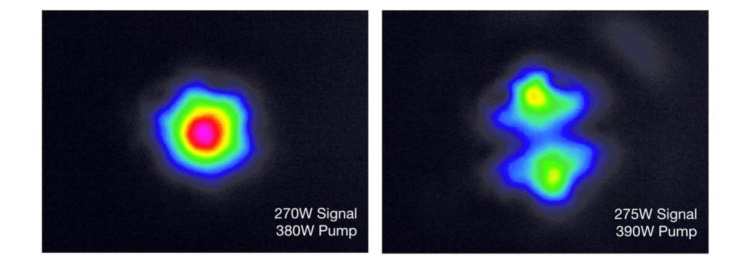 Mode instabilities: Above a threshold power level that depends on a number of parameters, instabilities can cause a good single-mode beam to degrade into a poor-quality, unstable multimode signal. [T. Eidam et al., Opt. Express 19, 13218 (2011)]
Mode instabilities: Above a threshold power level that depends on a number of parameters, instabilities can cause a good single-mode beam to degrade into a poor-quality, unstable multimode signal. [T. Eidam et al., Opt. Express 19, 13218 (2011)]
In a tutorial at OFC 2017, Jens Limpert of FSU Jena said that this transverse-mode instability arises from thermal effects that occur after power density in the fiber exceeds a threshold value. Below the threshold, the laser generates a stable single-mode beam of good quality. Degradation can begin at powers of several hundred watts to more than a kilowatt, causing the beam quality to drop as unstable higher-order transverse modes appear and the laser shifts to multimode operation. Above threshold, output in the center of the beam varies chaotically.
The power threshold for these effects, which show up in both pulsed and continuous-output fiber lasers, depends on multiple factors, including the structure of the active fiber, the seed power used in the final amplifier stage, and details of the system design. Transverse-mode instabilities occur on millisecond timescales and cause fundamental-mode power to vary from near-zero to more than 90 percent of the power, with most of the rest of the power transferred to the LP11x and LP11y modes.
According to Limpert, interference between modes effectively writes a refractive-index grating in the fiber, triggering the instabilities. An Optics Express paper published by his group this year showed that modulating the pump lasers in ways calculated to wash out the thermal grating could improve power and beam stability at powers up to twice the normal threshold for onset of the instability. The authors say the technique should be easy to incorporate into other fiber laser systems.
Peak power in pulsed fiber lasers
The millisecond timescales of transverse-mode instabilities are far too long to affect ultrashort pulses in fiber lasers. However, peak fiber laser powers have long been limited by nonlinear effects and self-focusing that arise from the small diameter of fiber cores. Increasing mode field area allows higher powers, but does not eliminate the limits. Chirped-pulse amplification also eases limits, but has its own power limits arising from the maximum feasible sizes of the gratings used to stretch and compress pulses. Those effects have capped peak femtosecond powers of single emitters below 10 GW, according Arno Klenke and colleagues from Limpert’s group. But they say coherent beam combination can ease that limit.
One approach is to divide pulses from a single source among parallel fiber amplifiers and to coherently combine their outputs by precisely matching pulse propagation distances. In Optics Letters this year, Klenke and colleagues reported amplifying 40-ps pulses divided among 16 parallel amplifying cores in a multicore fiber, then coherently combining their output with 80 percent efficiency to reach a 70-W average power.
Overall, the output powers of fiber lasers have soared by a factor of 100,000 since 1995, so we can’t complain too much about the current slowdown.
An alternative is temporal pulse combination, which delays pulses sent through separate channels to stack a series of pulses on top of each other, increasing the peak power. This also requires coherent beam combination, but works in different ways.
More to come
“High power” is inherently a relative term. Fiber lasers can concentrate high power at a single frequency, so the power per unit wavelength is quite high, making the output valuable for applications such as frequency conversion, remote sensing and microscopy. Thus high-power fiber lasers aren’t just for slicing metals or zapping military targets; they have opened a wide range of possibilities.
Overall, the output powers of fiber lasers have soared by a factor of 100,000 since 1995, so we can’t complain too much about the current slowdown. The progress has come from controlling the flow of optical energy and confining it within small volumes to make interactions of light and materials as efficient as possible. Well over half the pump light that enters a fiber laser can emerge as highly directed light in the laser beam. That’s already an impressive achievement—and there’s more to come.
Jeff Hecht is an OSA Fellow and freelance writer who covers science and technology.
References and Resources
-
M.N. Zervas and C.A. Codemard. “High-power fiber lasers: A review,” IEEE J. Sel. Top. Quantum Electron. 20, 0904123 (2014).
-
Phillip Sprangle et al. “High-power lasers for directed-energy applications,” Appl. Opt. 54, F201 (2015).
-
L. Dong and B. Samson. Fiber Lasers: Basics, Technology, and Applications (CRC Press, 2016).
-
J. Limpert. “High-power fiber lasers,” OFC Conference, OSA Technical Digest (Optical Society of America, 2017), paper W1F.5.
-
A. Klenke et al. “Coherently combined 16-channel multicore fiber laser system,” Opt. Lett. 43, 1519 (2018).
-
C. Jauregui et al. “Pump-modulation-induced beam stabilization in high-power fiber laser systems above the mode instability threshold,” Opt. Express 26, 10691 (2018).
-
A. Klenke et al. “Coherent beam combination of ultrafast fiber lasers,” IEEE J. Sel. Top. Quantum Electron. 24, 0902709 (2018).
